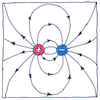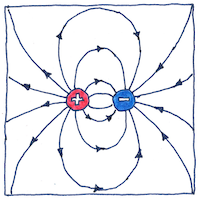Benjamin Franklin
electromagnetism

|
Electric charge
Benjamin Franklin conducted experiments with static electricity and discovered that pointed bodies conduct electricity more readily than rounded bodies, leading directly his inventing the lightning rod. He was the first to understand the difference between “a plenum of electrical fire” which he said was electrified positively or plus and “a vacuum of the same fire” which he said was electrified negatively or minus. He understood that the parts of electrical matter repel each other, but are attracted by other matter, so that electrified water molecules in a cloud repel each other until they are discharged as lightning, whereupon drops coalesce and fall as rain. He was the first to claim that electrical charge is conserved, and he was the first to show that static electricity gathered by friction and stored in a Leyden jar is the same as the electricity generated by an electrical storm and conducted to a key by the wet string of a kite.
Electric pleasures
“A turkey is to be killed for our dinner by the electrical shock, and roasted by the electrical jack, before a fire kindled by the electrified bottle.” —Benjamin Franklin, 1748 Or so we read on our electric monitor of the electric computer from a distant electric archive of an electric version of Franklin’s book, Experiments and Observations on Electricity.
Electronic addiction
Users addicted to electronics argue electronics are good for them. There was a time when mankind could not control electrons. It would be foolish to argue lives were better then, and it would be foolish to argue we have no more to learn.



Ben Franklin coined the term battery for multiple Leyden jars connected in parallel.
Ben Franklin also wrote a ground-breaking paper on population growth, he worked with his cousin Timothy Folger to chart and name the Gulf Stream, he was an early defender of Christiaan Huygens’ wave theory of light, he contributed to meteorology, he invented traction kiting, he investigated the principle of refrigeration by evaporation, and he documented the effects of heating and cooling on electrical conductors, including discovering the nonconductivity of ice.
See also in The book of science:
Readings in wikipedia:
Other readings: